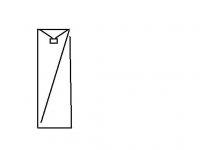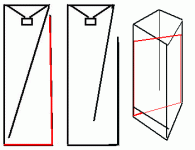Hello everybody!
I am using M. King`s sheet (original version without offset) to construct an enclosure for the Ciare HX201 in an "omnidirectional" setting (driver looking to the ceiling). What I don`t like so much about a standard folded TL is the direct line from the driver to the bottom, which should make a lot of dampening necessary. So I also considered to separate the box into two TLs. I started with the special case of a diagonal through the box separating the box into two identical TLs. I expected the peaks and holes to become more extreme with two identical resonators in series, but the opposite happened.
An other effect is that the rolloff is more flat and starts sooner.
Can I trust these results?
Oliver
I am using M. King`s sheet (original version without offset) to construct an enclosure for the Ciare HX201 in an "omnidirectional" setting (driver looking to the ceiling). What I don`t like so much about a standard folded TL is the direct line from the driver to the bottom, which should make a lot of dampening necessary. So I also considered to separate the box into two TLs. I started with the special case of a diagonal through the box separating the box into two identical TLs. I expected the peaks and holes to become more extreme with two identical resonators in series, but the opposite happened.
An other effect is that the rolloff is more flat and starts sooner.
Can I trust these results?
Oliver
el`Ol said:I am using M. King`s sheet (original version without offset) to construct an enclosure for the Ciare HX201 in an "omnidirectional" setting (driver looking to the ceiling). What I don`t like so much about a standard folded TL is the direct line from the driver to the bottom, which should make a lot of dampening necessary.
What IMHO will make a lot of dampening necessary is exactly your straight line with the driver at one end. Any other version (folded, offset driver or mass loaded will reduce the necessity for dampening.
So I also considered to separate the box into two TLs. I started with the special case of a diagonal through the box separating the box into two identical TLs. I expected the peaks and holes to become more extreme ...
Diagonal separation will reduce lateral resonances in the line.
... with two identical resonators in series, but the opposite happened.
From your description I would expect the resonators in PARALLEL. What did I miss? You probably need to a supply a drawing of your construction.

Rudolf
Aaaah, I see!
But I don´t believe, this will work as wanted. The influence of the second half of the line as a "resonator for the resonator" is negligible.
The only workable arrangements for the partition would be the ones shown in the second and third drawing.
But I don´t believe, this will work as wanted. The influence of the second half of the line as a "resonator for the resonator" is negligible.
The only workable arrangements for the partition would be the ones shown in the second and third drawing.
Attachments
I simulated both versions more detailed with the "sections"-sheet using minimal values for the closed end. Rolloff is similar, frequency response of the double-TL is still slightly less peaky.
The main difference is in the terminus velocity.
In the standard folded TL it is continuously falling. In the double-TL there is a steeper decline first and over 100 Hz it is fairly constant with slight peaks and holes.
What does the terminus velocity tell us?
The main difference is in the terminus velocity.
In the standard folded TL it is continuously falling. In the double-TL there is a steeper decline first and over 100 Hz it is fairly constant with slight peaks and holes.
What does the terminus velocity tell us?
Visaton B200
I did some more simulations, you need a BR if you really want to get above the infinite baffle response. The superiority of the double-TL is probably just because the HX201 is not really a TL-driver.
When I do the simulations with the Visaton B200 the superiority of the classical TL is obvious (really really nice responses). And maybe the B200 also works as an omnidirectional because of its rising frequency response.
I did some more simulations, you need a BR if you really want to get above the infinite baffle response. The superiority of the double-TL is probably just because the HX201 is not really a TL-driver.
When I do the simulations with the Visaton B200 the superiority of the classical TL is obvious (really really nice responses). And maybe the B200 also works as an omnidirectional because of its rising frequency response.
- Status
- This old topic is closed. If you want to reopen this topic, contact a moderator using the "Report Post" button.
- Home
- Loudspeakers
- Full Range
- double-TL useful?


